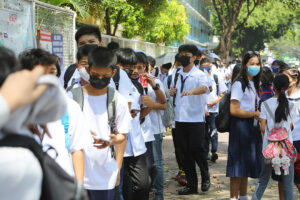One’s vote reflects one’s values

Monday, May 9, 2022, Filipinos all over the world will elect the 17th president of the Philippines, the vice-president, 12 senators, hundreds of district representatives and party-list congressmen, more than a thousand mayors and vice-mayors. Councilors, hundreds of board members, and more than 80 governors and vice-governors. That’s a few days from now, Thursday, May 5, and that’s quite a number of candidates whose qualifications and track record one has to evaluate and assess.
The first time we voted was in 1969: Ferdinand Marcos, Sr. was running for reelection against the Liberal Party candidate, Sergio Osmena, Jr.
Marcos’s running mate, Vice-President Fernando Lopez, was running against Genaro Magsaysay, younger brother of the late President Ramon Magsaysay. Marcos’s Nacionalista Party (NP) senatorial slate in the 1967 midterm senatorial, congressional and local elections, had run roughshod over the decimated Liberal Party (LP). Only Benigno “Ninoy” Aquino, Jr., former governor of Tarlac, who ran what was then considered by Philippine election standards, a scientific, technological, and highly mobile campaign featuring one of the then most modern Bell Jet helicopters. Ninoy finished second and, together with Gaudencio Antonino’s widow, Magnolia Welborn, survived the NP onslaught.
Gaudencio Antonino perished in a helicopter crash on Nov. 13, 1967, a day before the midterm elections. Magnolia took over the candidacy of Gaudencio Sr. and was elected senator in place of her husband.
Ninoy’s 1967 senatorial candidacy was under a cloud of doubt because he would not yet be 35 years old, the minimum age requirement to run for the Senate, by election day, Nov. 14, 1967. Ninoy’s 35th birthday was on Nov. 27. The Supreme Court later ruled that the word “elections” includes the days up to the proclamation of the winners. Winners were proclaimed in December 1967 thus paving the way for Ninoy to be the youngest senator at that time.
Ninoy had known that there were serious legal issues against his senatorial candidacy. All of the legal luminaries he consulted said so, including those from within the LP which, however, had run out of viable candidates. But Ninoy wanted to run and even volunteered to be Secretary-General of the then badly-decimated LP: there were then 15 NP senators against seven LP lawmakers in the upper chamber. Ninoy was ready to invest in the senatorial race, even if he was knocked out by the age issue, for the 1969 elections and was already looking forward to the 1973 presidential race.
It was therefore with great alarm that Ninoy met the news of Antonino’s death. He felt that people could mistake him for Antonino: “Aquino” and “Antonino” could lead to confusion among voters. In addition, both were known to be campaigning on helicopters. Ninoy felt voters might be so confused that he was the “Antonino” who died in a helicopter crash and any vote for him would just go to waste. It is to the credit of Ninoy’s information infrastructure to have acted so swiftly to counteract the negative effects of the Antonino tragedy during those days when there were no computers, cell phones, or social media to speak of. It merely reemphasized how media savvy the ex-Korean war journalist was.
Marcos’s and the NP’s messaging during the 1967 senatorial campaign was dominated by the so-called “RR and S” — Rice, Roads and Schools.
I got my second chance to vote in the 1971 senatorial elections. It was the last before Marcos declared Martial Law. Marcos and his NP almost completely dominated the 1967 polls, but 1971 was an entirely different story. The LP rode high on the emotional impact of the Plaza Miranda bombing and the message that Marcos lacked effective control of both law and order and the then-emerging insurgency situation, and won six of the eight senatorial seats being contested in 1971.
The LP was holding its miting de avance (a major rally) on the evening of August 21, 1971, at Plaza Miranda, the traditional stronghold of free speech, when three grenades tossed onto the LP stage exploded in rapid succession. The grenade attack caused the deaths of nine people including news reporters and photographers and injured close to a hundred, most of whom were LP members. The explosion almost wiped out the LP hierarchy which included party president Gerardo Roxas and his wife, Judy Araneta, Senator Jovito Salonga, and LP officials of the city of Manila including Ramon Bagatsing, Sr.
The grenade attack, which Marcos and his propagandists tried to pin on the Communists, was the main campaign message of the LP which continued to portray Marcos as a violent man who had no use for democratic processes.
The LP senatorial slate went by the acronym KIMMPOSS for Eva Estrada Kalaw, Eddie Ilarde, Monching Mitra, Gene Magsaysay, Salipada Pendatun, Sonny Osmeña, Melanio Singson, and Jovito Salonga. If memory serves me right, everyone in the slate but Pendatun and Singson was injured in the blast. Kalaw, Ilarde, Mitra, Magsaysay, Osmeña, and Salonga were injured and won. Only Alejandro Almendras and Ernie Maceda from the NP made it to the Senate in 1971.
Shortly after the Plaza Miranda grenade explosions, Marcos suspended the writ of the habeas corpus, the suspension of which could be used in order not to “present the body” of an imprisoned or detained person who has not been charged with any crime.
The 1971 elections were the last under the 1935 Constitution before Marcos imposed Martial Rule. He had barangay assemblies held to approve the 1973 Martial Law Constitution. No secret balloting was held. Citizens were just ordered to raise their hands to approve the constitution.
It was not until 1978 that some form of elections for regional representatives to the National Parliament, or Batasang Pambansa, were held. Except for the National Capital Region (NCR) or Metro Manila, and some parts of northern Mindanao, there was no viable or genuine opposition. Marcos created the Kilusang Bagong Lipunan (KBL). He then had his wife Imelda, the governor of Metro Manila and head of the Ministry of Human Settlements, head the 21-person KBL lineup for the NCR. Ninoy led the Lakas ng Bayan (LABAN) team and campaigned from his prison cell. Ninoy’s campaign included a prime-time interview on the government station moderated by the late Ronnie Nathanielsz whose pro-government bias became increasingly obvious as the night wore on. The night before the elections, a spontaneous noise barrage occurred which served as some kind of forecast of the possible outcome of the elections.
As expected, however, the elections, which were marred by violence, suppression of LABAN and its supporters and campaigners, turned out in favor of KBL: the party won all 21 seats with Imelda taking the top spot.
The 1978 elections did not have the elements of a democratic election: there was no freedom of assembly (LABAN rallies were harassed or requests for the group’s gatherings were either denied or altogether ignored); there was no freedom of speech; and the obvious bias of the Commission on Elections for the party in power delivered mortal blows against democracy.
There were, of course, other elections under Marcos, culminating in the snap presidential election in 1986. The whole world knows what happened and what the final outcome was.
As we all go to the polls on May 9, it may be worth reflecting on the statement of Bishop Jose Colin Bagaforo of the Diocese of Kidapawan that “one’s vote reflects one’s values.”
Philip Ella Juico’s areas of interest include the protection and promotion of democracy, free markets, sustainable development, social responsibility and sports as a tool for social development. He obtained his doctorate in business at De La Salle University. Dr. Juico served as secretary of Agrarian Reform during the Corazon C. Aquino administration.




